Of the five human senses, none are quite as powerful as that of scent. The often unseen and invisible nature of it has this magical ability to register powerful memories. Scent travels directly through the olfactory cortex, the region of the brain that’s tied to the limbic system – where memories are created and stored. For Los Angeles-based MAAPS and its Co-Founders, Johan and Char Lam, it’s about creating and exploring these deep connections.
“We really liked the idea of the hands-on aspect of incense and taking people back to the ritualistic aspect of it, in many ways how it was originally used. The whole process of lighting it, blowing it out, watching the embers blow, watching the smoke billow, it’s a sort of peaceful process. It’s a peaceful set of actions. When I light a stick of incense at the end of the day or at the office, it takes me out of the hustle and bustle.”
— Johan Lam, Founder of MAAPS
The incense is drawn with your left hand while your right hand reaches for a lighter…
Incense has never quite shaken its previous connotations revolving around religion and stoner culture. For several millenia, religion and incense were intrinsically intertwined. The latter was used as a method to ward off demons and spirits and help encourage the presence of gods.
Prior to the creation of incense, collecting the necessary resin and biotic materials to continually engage in these rituals was often difficult. Incense essentially introduced a new form of convenience and storage. Differing styles would take shape through Western-style gum resin from trees and plant-based Eastern world styles. The earliest examples of incense date back some 5,000 years to the prehistoric Egyptian tombs in El Mahasna.
The deep historical contexts of incense have an ingrained stigma. When reaching for that pack of incense, we’ve had to battle both an unfamiliarity with the product and for some, religious meanings.
The incense experience, however, offers something much different in the form of physical interaction. The act of picking a stick, putting it in a holder, lighting a match, and watching the smoke dance as it rises – it’s a very interactive process.
It was this process that drew Char and Johan Lam to start MAAPS, a Los Angeles-based incense brand. The two however live very different lives with careers to match. Char is an attorney in a world that emphasizes structure and rigidity in process. Johan is an entrepreneur and the founder of American denim label 3sixteen. His process, unlike Char’s, has an emphasis on flexibility and agility.
Before launching MAAPS, the market for high-quality incense was sparse. The options within the United States were often limited and of low-quality or expensive and of a mediocre quality.

Stacks of MAAPS custom incense sit on the floor of their Downtown Los Angeles studio.

The MAAPS packaging and brand identity was designed by designer, Chuck Anderson/No Pattern Studio.
“It’s been interesting to see everybody’s preconceptions. It’s a very divisive product in that some people have preconceived notions.”

Johan Lam reviews a new batch of MAAPS scent.
Developing the initial product included help from a close friend of Johan’s:
“One of my friends, this is his family business. He’s been in the business for a long-time. Him and his mom have been working in essential oils, and she’s a licensed aromatherapist. They’ve been making things for a long time. Partnering with them put me at ease, knowing that the product would be made by people who were experienced and it wasn’t left to us.”
This expert backing would provide the necessary foundation to create a high-quality and expertly made product. But the next barrier was educating those unfamiliar with incense. Given its aforementioned early religious or medicinal uses, it’s an uphill battle to break the chains that link incense solely to the past.
“In most Asian cultures, it’s more for Buddhist ceremonies or more ceremonial purposes. In some American [cultures], it’s been very tied to weed and hippy culture. It’s been interesting to see everybody’s preconceptions. It’s a very divisive product in that some people have preconceived notions.”
Another potential obstacle to the successful re-introduction of incense into modern lifestyles is the candles that have come to dominate the household aromatics market. Their comparatively neutral image and widespread use has resulted in well-stocked candle sections at lifestyle stores around the world. That said, MAAPS wasn’t content with reinforcing the norm, looking instead toward opportunities ahead.
“I think everybody’s been doing candles. If you step into any menswear, womenswear, or homegoods store, there are several candles in there already. They carry several candles in there. They already carry a candle brand, they carry their own candle brand or they stock the candles of the [fashion] brands they carry. It was something that we could definitely do. But we felt we weren’t providing a new voice or something interesting. That market is already pretty saturated. It is something that is experientially wider. A candle is more palatable and it’s more familiar with less of an acquired taste in scent. The smell of incense is very particular. We could have definitely done [a candle], but we felt like we weren’t adding our own voice.”
Cultural perceptions aside, there are technical differences between the two olfactory mediums that result in different experiences. Incense and candles burn differently such that the exact same scent on paper comes to life in different ways once lit, a nuance that Johan explains in simple terms.
“It has to do [with] the methods and how the resin is burning off the stick. In a candle, the wick is heating up the essential oils in the wax around it. The incense is actually burning the resin and adds a bit of sharpness to the smell. It’s just naturally different. Even if you put the same essential oils between incense and a candle, it provides a different experience. “
As each stick burns, they carry their own timer. The amount and length of the resin determines the length of the experience. Which means, without intervention, the fragrant smoke stops on its own. For Char, this enables one to switch incense accordingly and with a sense of variation.
Char chimes in about the relative ease in switching up sticks and how the nature of the product allows for more variations. It’s easier to amass a diverse selection of incense sticks and change it up accordingly. “I think what’s really interesting about incense is that you can create several different scents. It burns for about 45 minutes and you can switch it up. If you feel a certain way, you can change it up.”
The smoke slowly emerges from the tip of the stick…
Moving deeper into the relationship of scent and experience, Johan delves into how he perceives scent and its ability to transport to another place. The brand’s name itself is a reference to how scent can transport you to a place previously traveled.
“The idea behind the name MAAPS is that a scent has the ability to transport you. My sense of smell is really acute for better or worse. Sometimes it’s a curse. My smell is really tied into my memories. So that was the idea behind the name [MAAPS]. All the scents have geographical terms that they’re named after. They’re loosely named after a region or a vibe. ”
There’s a lot of science to support this concept. Olfactory memory, or a recollection of memories based on smells, is one of the mind’s most powerful connections. The olfactory bulb is a place within the brain that processes scent. It’s one that connects directly with scent unlike the pathways for sight and sound. NY Times’ science journalist Natalie Angier states in a 2008 article that “new signals detected by our eyes and our ears must first be assimilated by a structural way station called the thalamus before reaching the brain’s interpretive regions, odiferous messages barrel along dedicated pathways straight from the nose and right into the brain’s olfactory cortex, for instant processing.”
This direct response to scent is further compounded by the fact that “the olfactory cortex is embedded within the brain’s limbic system and amygdala, where emotions are born and emotional memories stored.”
One of Johan’s close friends was a defining example of this olfactory connection.
“We have a scent called Heartwood and it’s essentially made of palo santo (wood)… It’s a wood that was used in a lot of spiritual ceremonies in South America. A lot of people would burn it for ceremonies. In incense form, it smells a lot like licorice. We had a friend stop by, and we wanted to give them some incense. We weren’t sure if he would like Heartwood because licorice is a very polarizing scent. I handed it to him and asked ‘is this something you’d like?’ He replied ‘I love this it reminds me of when I was running track because where we used to run used to smell exactly like this and it brings back fond memories.’ Everybody has these fond memories and if they don’t smell it for a long time, they are instantly transported.

… the smoke wafts through the room.
Watching the incense smoke rise creates a sense of serenity for Char.
“Just sitting there watching the smoke blowing in different directions based on the day… there’s something captivating and mesmerizing about it. It is really therapeutic for me. We made a few incense holders and depending on what angle it’s titling at, I can just sit there and watch it.”
As the smoke rises, it never follows a straight line but rather incorporates the influences of the surrounding areas. There isn’t a sense of rigidity to the motion. It all happens in a very fluid and dynamic manner. This differs from Char’s day-to-day workings as a lawyer, where many procedures are very much by the book. As a husband and wife duo, Johan’s experiences building brands has offered some new and interesting insights for Char. He talks about the occupational differences:
“What we’re doing now is not as rigid or rule driven as Char’s dayjob. In law, things are specifically worded and there’s a procedure to everything. When starting a brand, we could go a million different directions and there isn’t a hard and fast way to success. For me, it’s been interesting to show her my thought process and key her into how certain decisions will affect the brand and how I can see from being in the industry for over a decade. I’m able to share with her and get her opinion which is hopefully different from mine or gives me a new perspective and we can jointly make a decision.”
“In any other working relationship, you could leave that relationship, you could quit or leave… but for us that’s not going to happen. Whether the company folds or not, we’ll still be together. That allows us to be a bit more honest.”

The union of marriage insinuates a deeper bond and one that holds each partner to a different set of measures. The natural trust of a healthy marriage translates into MAAPS. Char and Johan both have a genuine and honest grasp of the decisions each other puts forth. There have yet to be any full-blown battles but in the event of any disagreements, there’s a major tent pole for both to lean on:
“The best part of this partnership is that you know where the other stands. I can trust Char with anything. I know at the end of the day she has my best interest and the company’s best interest in mind. Whatever disagreements or arguments we may have, they come from a place of wanting to do better. We don’t have to necessarily be as sensitive to one another because there’s that basis of trust. In any other working relationship, you could leave that relationship, you could quit or leave… but for us that’s not going to happen. Whether the company folds or not, we’ll still be together. That allows us to be a bit more honest.”
MAAPS is essentially in the beginning stages of building its brand. The space in which they operate lacks the type of product they’ve presented. A well-designed and thoughtful approach is always welcome, regardless of category. The unfamiliarity in this area does mean that there’s more work to be done in the educational process. Yet, several factors are firmly on their side. A rock solid relationship carried over from a personal perspective allows Char and Johan an almost unfiltered working relationship. The natural experience of Johan and the understanding that entrepreneurship’s rise and growth follows not so much a structure, but a living and breathing approach. It’s not about geometrically neat building blocks. It’s about adapting with the influences that surround you and continuing to rise amidst these factors.
It’s an incense stick’s rising smoke.



The Popularity Surrounding Handcrafted Ceramics
In the world of artisanal and analog items, ceramics are becoming an increasingly popular avenue of exploration. The handmade origins of perfectly imperfect products resonate with a demographic that has consciously pushed away products that lack soul and the human touch. Johan and Char share with us the new-found interest in ceramics as well as how they stumbled into their own MAAPS holders, created by fellow friend Phill Kiho Kim of PKK Ceramics.


Shelves of finished ceramics sit inside the PKK Ceramics studio.

Phill of PKK Ceramics contours a custom MAAPS incense holder.

Phil’s ceramic experimentations are strewn throughout his Los Angeles studio.


MAAPS incense holders sit beside a window as they dry.

Phil observes a completed MAAPS incense holder.


























